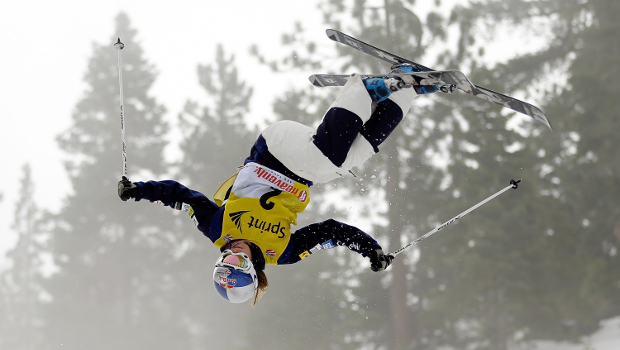Skiers, especially those preparing for this February’s Winter Olympics in Sochi, Russia, might be the world’s best masters of achieving flow—and the happiness that comes along with it.
Heather McPhie had never felt sicker. Heather, the defending national champion in mogul skiing, was at the U.S. Freestyle Championships at California’s Heavenly ski resort last March. The week before, she’d come down with a horrible sinus infection, which she was trying to fight off with antibiotics.
The drugs appeared not to be working, and her symptoms—runny nose, achiness, chills—seemed to peak on the Friday of the biggest contest of her season. She was one of the clear favorites to win.
Between qualifications and finals, Heather slept for a couple of hours under a table in the VIP tent. She was too tired to take her inspection run, a critical step in planning and visualization.
A rare fog settled over the mountain, and visibility was poor. At the top of the course, Heather put her headphones on and tried to push away all of the negativity—her illness, the weather.
“It was incredibly stressful, but I quieted my mind,” she says. “You never know what’s going to happen and there are so many variables, so I just focused on my breathing.”
She stood in the starting gate as an official counted her down. Three. Two. One. Go! When she pushed off, everything came into sharp focus. Her brain and body, hard-wired to perform thanks to years of training, kicked into overdrive. Time seemed to dissipate and whatever had been bothering her before suddenly vanished.
She carved meticulous high-speed turns through the mogul field, wriggling her way down the mountain with the grace of a ballet dancer and the speed of a race car driver. On the first jump of the course, Heather did a huge layout, her body straight as she flipped into the air, landing solidly on both skis. On the second jump, she went for a D-spin, a 42 difficult off-axis 720 (two complete rotations), again landing with ease.
The run earned her a miraculous victory and cemented her second national championship title. Her win also nearly guaranteed Heather a chance to represent the United States in mogul skiing at the Winter Olympic Games this February in Sochi, Russia.
So just how did a girl who was sick and sleeping under a table hours earlier transform herself into a national champion and pending Olympian in a matter of moments? The answer is something even she can’t quite explain.
“It was the like the perfect storm,” Heather says. “I barely remember actually skiing that run. I crossed the finish line, and I was like, ‘I’m not sure exactly what I just did,’ but I knew it felt really good. It was just a feeling. You can’t think your way through it.”
This trance—an instinctual mental state that gives way to a sense of effortless concentration—is something that psychologists have spent the last five decades attempting to figure out. The phenomenon has a name: flow.
And flow, it turns out, may also hold the key to happiness.
Tapping into Flow
Dating as far back as Aristotle, there is evidence that man could become absorbed by one singular thing.
“Flow with whatever may happen, and let your mind be free,” wrote Chuang-Tzu, a Chinese philosopher who lived around the fourth century B.C. “Stay centered by accepting whatever you are doing. This is the ultimate.”
But the idea wasn’t formally named until the 1970s, when a Hungarian-born researcher named Mihaly “Mike” Csikszentmihalyi (pronounced cheeksent-me-hi), now considered the founding father of flow, debuted his findings. In his research, he described flow as the mental state in which people become so intensely involved in a specific activity that nothing else appears to matter.
He came upon the subject from his own experiences. As a child, Mike and his family were held in an Italian prison camp during World War II. He used chess to find a mental escape. “I discovered chess was a miraculous way of entering into a different world where all those things didn’t matter,” Mike once said. “For hours I’d just focus within a reality that had clear rules and goals.”
In 1990, Mike published the book Flow: The Psychology of Optimal Experience which became a national best seller. In it, he explained that flow typically occurs when a person stretches his or her mind or body to its limits to achieve something both difficult and worthwhile.
That experience, his research found, turned out to be a critical step toward living a happy life. “Happiness, in fact, is a condition that must be prepared for, cultivated and defended privately by each person,” he wrote. “People who learn to control inner experience will be able to determine the quality of their lives, which is as close as any of us can come to being happy.”
According to his research, Americans report that they experience something akin to flow several times per day, while about 15 percent of people say they never encounter it. He found that musicians, artists and athletes achieved flow most frequently.
But for many people, finding flow isn’t as simple as it sounds.
“There’s something about flow that’s really intriguing,” says Daniel Tomasulo, an instructor of applied positive psychology at the University of Pennsylvania. “The goal is clear, there’s a very high degree of focus and people can lose their consciousness by engaging in the action.”
Through flow, Daniel says, time and reality can appear distorted. “Flow is like all altered states; it’s a type of high,” he says. “And because of that, everybody wants flow.”
But how, exactly, do you achieve flow? There’s no easy, front-door entrance, sadly.
The way Daniel describes flow, it sounds more like a secret rabbit hole into Wonderland. “If you’re too anxious, you’re not going to be able to function. If you’re too bored, you’re not going to be engaged,” Daniel says. “Being in flow straddles those two extremes. What you’re trying to do is find a portal between the two that pulls you into the flow zone.”
If there’s one group of athletes that flow researchers often point to for their high frequency of flow, it’s skiers.
 Mike often used skiing as a vehicle to describe flow. “Imagine that you are skiing down a slope, and your full attention is focused on the movements of your body,” he writes. “There is no room in your awareness for conflicts or contradictions; you know that a distracting thought or emotion might get you buried face down in the snow. The run is so perfect that you want it to last forever.”
Mike often used skiing as a vehicle to describe flow. “Imagine that you are skiing down a slope, and your full attention is focused on the movements of your body,” he writes. “There is no room in your awareness for conflicts or contradictions; you know that a distracting thought or emotion might get you buried face down in the snow. The run is so perfect that you want it to last forever.”
Perhaps skiers are more apt to find flow because their sport—which takes place in an often high-risk mountain environment—requires utmost focus and blends challenge with thrill and reward. Or perhaps it’s just because skiers have found the rabbit hole.
“In flow, the activity feels effortless. You’re totally engaged from the inside out,” Daniel says. “A skier, for example, might have some ailment, but as soon as they’re in flow, the ailment almost magically goes away.”
Staying in the Present
In 2007, Heather’s first year on the World Cup, the most competitive circuit for elite mogul skiers, she earned rookie of the year. In 2010, she competed at her first Olympics, the Vancouver Games, and she qualified for finals but then crashed. The more intense the competition got, the more anxious she felt.
“I kept choking under pressure,” Heather admits.
Over the next few years, she battled injuries, while self-doubt and anxiety continued to plague her. As a result, she was struggling to break into the top 10.
“I wonder what you could do if you believed in yourself,” her boyfriend said to her around that time.
The comment struck her. “For the first time, I realized I was really holding myself back,” she says now. “I doubted myself. I was exhausted and constantly saying, ‘I could be doing more.’ I was just pinballing.”
Her coach offered to set her up with a sports psychologist and with that help, McPhie slowly worked through her mental obstacles. She’d always trained intensely on a physical level to get her body ready for the winter season, but never before had she thought she had to train her mind, too.
I worked on not worrying about the past or the future but just being here,” she says. “I have made amazing strides.”— Heather McPhie
She learned to focus on the present, the here and now. “I worked on not worrying about the past or the future but just being here,” she says. “I have made amazing strides. Now, I’m much more comfortable with myself. I’m so much happier. I’ve become more relaxed. It’s a constant thing and every day is different. Every day you have a choice.”
In addition to being happier, Heather also started to perform better. In 2012, she earned four World Cup podiums and her first U.S. National Championship title. In 2013, Heather had the best season of her career, including five World Cup podiums, three of them gold, and her second National Championship title (while, of course, suffering from a sinus infection). She finished last season ranked third overall in the world, heading into this Olympic year.
She says her skiing became more consistent and she was able to push herself to try more difficult tricks. In other words, without even trying to, by focusing on the present and pushing away negative thoughts, Heather reached flow nearly every time she dropped into a contest run.
Her next challenge will be keeping that focus during the Olympics this February, where Heather, 29, will be one of the top American women to watch in mogul skiing.
“My dream for the Olympics is to have the best run of my life,” she says. “I want gold, don’t get me wrong, I’ve dreamt of that moment. But I’m doing everything I can to stay focused on what I can control. I’m really excited to see what I can do.”
Pushing Out the Negative
Like Heather, Noah Bowman started crumpling under pressure.
The Canadian halfpipe skier from Calgary, Alberta, broke onto the competitive freeskiing scene as an alternate at the X Games in Aspen, Colo., in 2012. He wasn’t planning to compete, but when another skier got hurt, Bowman nabbed a spot in the qualifiers.
With no pressure and no expectations, he breezed through to the finals, where he landed a switch alley-oop double 900. This insanely technical trick involves a backward take-off with two and a half rotations and two inverted flips. Noah learned the maneuver just days earlier and no skier had ever landed it before. The trick helped Bowman secure a silver medal at his rookie X Games appearance.
Looking back, Noah knows he was in flow at that time. “It felt as if I wasn’t thinking about anything, my subconscious took over and everything felt natural,” he says. “I had no outside or negative thoughts and it opened the door to continuously move forward and progress.”
But in 2013, now a skier to watch and with halfpipe skiing slated for its Olympic debut in Sochi, Noah felt the glare of the world. He couldn’t commit going into the harder tricks, he felt distracted and he fumbled with moves that previously came naturally to him. His results reflected it—he narrowly missed qualifying for finals at both X Games events last winter.
This summer, he knew if he wanted a chance to compete at the 2014 Olympics, he’d need to figure out what was stuck in his path. He worked with a mental trainer and found that stress and negativity were stopping him from getting into flow.
“I’ve been able to identify these problems and step past them. I now have a much stronger understanding of flow state and what it takes to achieve it on a regular basis,” Noah, 21, says. “For me it comes down to one very simple thing to get into the flow, and that is fun. Fun is the spark that gets the momentum going, the energy up, and allows me to take myself to new levels.”
This winter, when Noah is standing at the top of the halfpipe, waiting for his moment to drop in, whether he’s on Olympic primetime or just out skiing with friends, he’ll be controlling his thoughts, replacing all negative emotions with positive ones. But mostly, he’ll be having fun.
He suggests you do the same.
“What it really comes down to is finding things that allow you to access flow,” he says. “Find something that makes you happy, something you are passionate about, and then pursue it. You will feel the zone when you do something you love and over time you will learn to control the flow.”
Megan Michelson is the freeskiing editor for ESPN.com and a freelance writer, based in Tahoe City, California. She previously worked as an editor for Skiing and Outside magazines and she’s skied everywhere from Alaska to Iceland.















